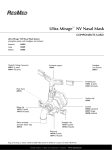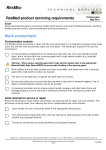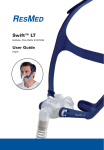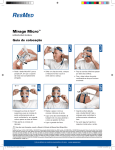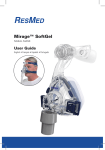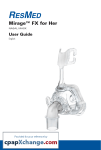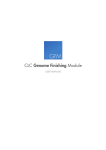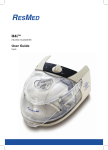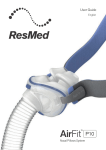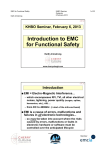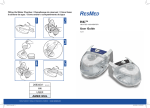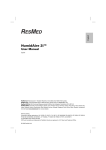Download Mirage Micro™
Transcript
Mirage Micro™ nasal mask User Guide English English Mirage Micro™ nasal mask Thank you for choosing the Mirage Micro™. Rx Only Intended Use The Mirage Micro channels airflow noninvasively to a patient from a positive airway pressure device such as a continuous positive airway pressure (CPAP) or bilevel system. The Mirage Micro is: •• to be used by adult patients (>66 lb/30 kg) for whom positive airway pressure has been prescribed •• intended for single-patient re-use in the home environment and multipatient re-use in the hospital/institutional environment. Before Using the Mask WARNINGS •• The vent holes must be kept clear. •• The mask should not be used unless the CPAP system is turned on and operating properly. •• Follow all precautions when using supplemental oxygen. •• Oxygen flow must be turned off when the flow generator is not operating, so that unused oxygen does not accumulate within the flow generator enclosure and create a risk of fire. •• At a fixed flow rate of supplemental oxygen flow, the inhaled oxygen concentration varies, depending on the pressure settings, patient breathing pattern, mask, point of application and leak rate. •• The technical specifications of the mask are provided for your clinician to check that they are compatible with the flow generator. If used outside specification or if used with incompatible devices, the seal and comfort of the mask may not be effective, optimum therapy may not be achieved, and leak, or variation in the rate of leak, may affect the flow generator function. •• Discontinue using the Mirage Micro if you have ANY adverse reaction to the use of the mask, and consult your physician or sleep therapist. •• Using a mask may cause tooth, gum or jaw soreness or aggravate an existing dental condition. If symptoms occur, consult your physician or dentist. •• As with all masks, some rebreathing may occur at low CPAP pressures. 1 •• Refer to your flow generator manual for details on settings and operational information. Flow Generator Settings Select ‘Standard’ (or ‘Vista’ for VPAP Adapt SV™) as the mask option when using the Mirage Micro with ResMed flow generators that have mask setting options. For a full list of compatible devices for this mask, see the Mask/ Device Compatibility List on www.resmed.com on the Products page under Service & Support. If you do not have internet access, please contact your ResMed representative. Parts of the Mask & Ordering Information Complete system S* 16333 M&L* 16334 LW&XL* 16335 Frame system (no headgear) S* 16378 M* 16379 L* 16380 LW* 16381 XL* 16382 Frame assembly (no headgear, no cushion) S* 16383 St* 16384 Forehead support pad 60123 (1) 60124 (10) Elbow assembly (elbow, swivel) 16399 Forehead support 16393 Mask cushion 16388 (S*) 16389 (M*) 16390 (L*) 16391 (LW*) 16392 (XL*) Dial 61289 Mask frame 16395 (S*) 16394 (St*) Elbow 16387 Swivel 16565 Headgear clip 16569 (2) 16734 (10) Ports cap 16570 (2) 16571 (10) Upper straps Headgear 16118 (S*) 16117 (M) 16119 (L*) Lower straps S* Small; M* Medium; L* Large; LW* Large-Wide; XL* Extra-Large; St* Standard 2 1 Turn the dial, so that the forehead support is fully extended. 4 Unfasten the Velcro®, pull the upper headgear straps evenly until they are comfortable and firm, and reattach the Velcro. 7 Lie down in your sleeping position. Adjust the dial until the mask is evenly positioned on your face. It should be comfortable, with a satisfactory seal. Adjust the headgear straps if necessary. 2 3 Hold the mask over your nose and pull the headgear over your head. 5 Bringing the lower straps below your ears, connect the headgear clip to the the mask frame. 6 Repeat step 4 with the lower headgear straps. Connect the main air tubing to the swivel. Then connect the free end of the air tubing to your flow generator and turn the flow generator on. 8 The fitted mask is shown above. 3 Removing the Mask Disconnect one of the headgear clips and pull the mask and headgear up over your head. English Fitting the Mask Disassembling the Mask 1 Detach the air tubing. 4 2 3 Unclip the headgear clips and unthread the upper headgear straps. It is not necessary to remove the headgear clips from the headgear. Remove the elbow assembly from the mask frame by pivoting from the bottom edge. 5 (b) (a) Remove the swivel from the elbow. 6 Remove the forehead support pads from the forehead support. Note the position on the dial for the next time you use the mask. Unscrew and remove the dial (a) then pull the forehead support (b) out of the mask frame. 7 8 Remove the cushion from the mask frame. 4 Remove the ports cap from the mask frame. Notes: •• The mask and headgear should be cleaned by handwashing. •• The headgear may be washed without removing the headgear clips. WARNING Do not use aromatic-based solutions or scented oils (eg, eucalyptus or essential oils), bleach, alcohol or products that smell strongly (eg, citrus) to clean any of the mask components. Residual vapours from these solutions can be inhaled if not rinsed thoroughly. They may also damage the mask, causing cracks. CAUTION •• If any visible deterioration of a mask component is apparent (cracking, crazing, tears etc.), the mask component should be discarded and replaced. •• Avoid connecting flexible PVC products (eg, PVC tubing) directly to any part of this mask. Flexible PVC contains elements that can be detrimental to the materials of the mask, and may cause the components to crack or break. Daily/After Each Use To optimize the mask seal, facial oils should be removed from the cushion before use. Handwash the mask by gently rubbing in warm (86°F/30°C) water using mild soap. If the vent requires cleaning use a soft bristle brush. Rinse all components well with drinking quality water and allow them to air dry out of direct sunlight. Do not soak the mask. Weekly Handwash the headgear in warm (approx. 86°F/30°C) water using mild soap. Reprocessing the Mask between Patients This mask should be reprocessed when used between patients. Cleaning, disinfection and sterilisation instructions are available from the ResMed website, www.resmed.com/masks/sterilization/americas. If you do not have Internet access, please contact your ResMed representative. 5 English Cleaning the Mask at Home Reassembling the Mask 1 2 Insert the cushion into the mask frame. Ensure that the arrows at base of the cushion and mask frame are aligned. Insert the ports cap. 4 3 (c) (a) Push the forehead pads firmly into the forehead support. 5 (b) Insert the forehead support (a) into the mask frame and screw (b) the dial clockwise onto the pole. Turn the dial until it clicks (c). Ensure the dial sits flush against the frame. 6 Insert the assembled elbow into the mask frame. 7 Reattach the top headgear straps by threading them through the loops. 6 Insert the swivel into the end of the elbow. Problem Possible reason Possible solution Mask won’t seal properly or is uncomfortable Mask may have been fitted incorrectly or is incorrectly adjusted. Carefully follow instructions in “Fitting the Mask”. Check headgear and dial are not overtightened. Extend dial to apply more force to upper lip. Shorten dial to increase force at nose bridge. Mask is wrong size. Talk to your clinician. Mask cushion is skewed in mask frame. Check insertion of cushion and reinsert correctly according to the instructions in “Reassembling the Mask”. Mask cushion is misaligned or creased on face. Ensure cushion is properly aligned according to the instructions in “Reassembling the Mask”. Make sure the cushion has no creases in it: undo headgear clip, check cushion and reposition the mask over your nose. Mask cushion may be dirty. Clean cushion according to instructions in “Cleaning the Mask at Home”. Mask is assembled incorrectly. Reassemble mask. Vents are blocked or partially blocked. Clean vents according to instructions in “Cleaning the Mask at Home”. Misassembly. Push dial base onto a hard surface until the dial comes out of the frame. Mask is too noisy Dial inserted into mask frame before forehead support Symbols Caution, consult accompanying documents; LOT Lot number; REF Part number; Temperature limitation; Humidity limitation; Does not contain latex; Indicates a Warning or Caution and alerts you to a possible injury or explains special measures for the safe and effective use of the device. 7 English Troubleshooting Limited Warranty ResMed warrants that your ResMed mask system, including its components: mask frame, cushion, headgear, tubing and other accessories (“Product”) shall be free from defects in material and workmanship for a period of ninety (90) days from the date of purchase by the initial consumer. For further details refer to the Warranty. Technical Specifications Note: The mask system does not contain latex, PVC or DEHP materials. Pressure–Flow Curve The mask contains passive venting to protect against rebreathing. As a result of manufacturing variations, the vent flow rate may vary. 50 Vent Flow Rate (L/min) 45 40 35 Flow (L/min) 4 19 8 28 12 34 16 40 20 45 30 25 20 15 10 5 0 4 Dead Space Information Pressure (cm H2O) 6 8 10 12 14 16 Mask Pressure (cm H2O) 18 20 The dead space of the mask varies according to cushion size. It is 128 mL for the Extra Large size. Therapy Pressure 4 to 20 cm H2O Resistance Drop in pressure measured (nominal) at 50 L/min: 0.1 cm H2O at 100 L/min: 0.7 cm H2O Environmental Conditions Operating temperature: +41°F to 104°F (+5°C to +40°C) Operating humidity: up to 95% non-condensing Storage and transport temperature: -4°F to 140°F (-20°C to +60°C) Storage and transport humidity: up to 95% non-condensing Gross dimensions S: 140 mm (H) x 91 mm (W) x 93 mm (D) M, L, LW, XL: 155 mm (H) x 91 mm (W) x 98 mm (D) Mask fully assembled – no headgear. Note: The manufacturer reserves the right to change these specifications without notice. Storage Ensure that the mask is thoroughly clean and dry before storing it for any length of time. Store the mask in a cool dry place out of direct sunlight. Disposal The Mirage Micro does not contain any hazardous substances and may be disposed of with your normal household refuse. 8 ResMed Ltd (Manufacturer) 1 Elizabeth Macarthur Drive Bella Vista NSW 2153 Australia ResMed Corp (US Designated Agent) 14040 Danielson Street Poway CA 92064-6857 USA ResMed (UK) Ltd (EU Authorised Representative) 96 Milton Park Abingdon Oxfordshire OX14 4RY UK ResMed Offices Australia, Austria, Belgium, Brazil, China, Finland, France, Germany, Greece, Hong Kong, India, Ireland, Italy, Japan, Malaysia, Mexico, Netherlands, New Zealand, Norway, Portugal, Singapore, South Africa, Spain, Sweden, Switzerland, UK, USA (see www.resmed.com for contact details). Mirage Micro Nasal Mask Protected by patents: AU 710733, AU 741003, AU 766623, AU 775051, AU 777033, AU 785376, CA 2261790, EP 0956069, EP 1187647, EP 1187648, EP 1187649, EP 1187650, EP 1314445, EP 1479406, HK 1057714, JP 3686609, NZ 513052, NZ 526165, NZ 526166, NZ 526167, NZ 526168, US 6112746, US 6119693, US 6357441, US 6374826, US 6439230, US 6463931, US 6532961, US 6557556, US 6581594, US 6581602, US 6634358, US 6691708, US 6823865, US 6860269, US 6871649, US 6997188, US 7011090, US 7159587, US 7178527, US 7188620, US 7216647, US 7234466, US 7243651. Other patents pending. Protected by design registrations: AU 304309, CN 200530117106.1, EP 366844, JP 1264474, NZ 406357, US D532512, US D547439, US D545960. Others pending. AutoSet CS, Mirage and Mirage Micro are trademarks of ResMed Ltd. AutoSet CS and Mirage are registered in U.S. Patent and Trademark Office. Velcro is a registered trademark of Velcro Industries B.V. © 2008 ResMed Ltd. 1 2 3 4 5 6 618114-Eng/1 08 09 MIRAGE MICRO USER aMER MULTI 6 1 8 1 1 4 Global leaders in sleep and respiratory medicine www.resmed.com











